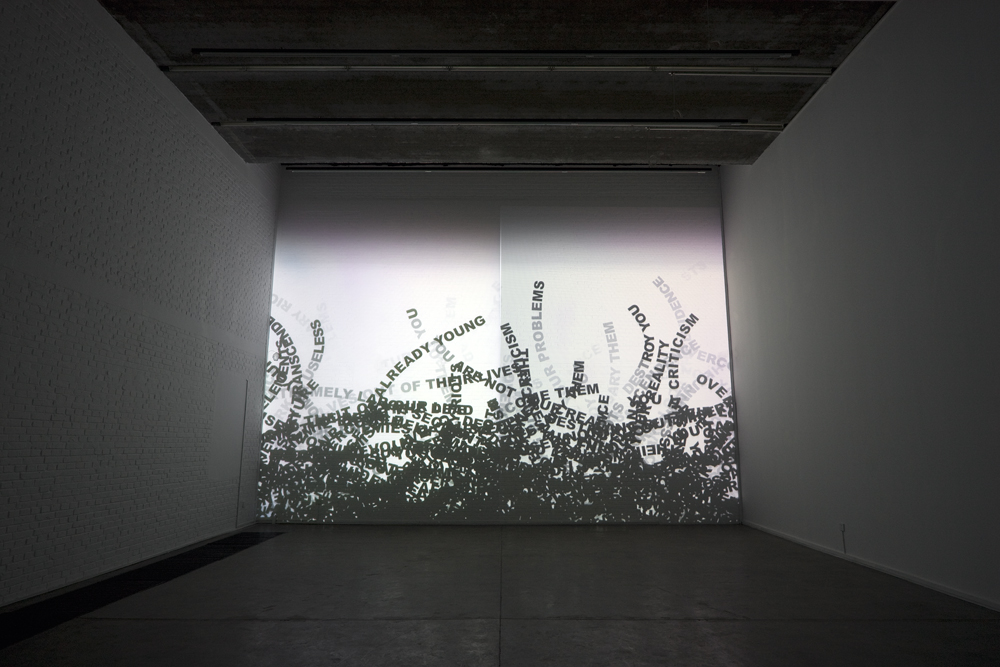Beyond Geography
2012 - Film & Video (Film & Video)
23:09 minutes
Li Ran
In his video work Beyond Geography , Li dramatizes the role of the artist-as-imitator to the point of sheer parody. Dressed to toe in the costume of a typical Discovery Channel adventurer-explorer, the artist dashes suavely through the uncharted jungle habitat of a primitive tribe. Li modulates his own voice in laughably accurate mimicry of the dubbed Discovery Channel protagonist familiar to Chinese viewership, daringly gulping fresh water from a river, expertly admiring exotic vegetation, and whimpering in fear of the dark sounds of the night (screaming, even, as he trips on a human skull) in an full-scale exaggeration of a nature show personality. None of these settings, however, is shot on “location” as the video takes place entirely in an empty 3-D digital film studio with a blue screen. Engaging in a near Brechtian conceit, Li deliberately keeps the studio space raw in order to remind us that these television programs are always deliberately artificial and produced. His project is entirely farcical, and just as there are not sets or props to lure the viewer into complacency, Li’s interactions with the indigenous tribesmen – whom Li “discovers” – becomes their own simulated performance of colonial appropriation and meetings of “first contact.” This narrative of appropriation carries throughout until, near the video’s end, Li (in full explorer persona) begins to make declarations about the tribe’s civilization, decreeing their cave paintings (never seen on camera) as masterpieces on par with Picasso and Mondrian. In assuming the guise of the pedantic academic, Li ends his video with a humorously condescending twist. At the same time, his video reminds us of the inherent dangers of confusing mediated representation with documentary while reminding us of the constant threat of cultural appropriation at play when we fail to see the blue screen for the the jungle and the artist for the explorer.
Li Ran produces video, installation, and performance-based works that examine various states of parody and simulacra in the digital world. Through performative narrative, reproduction, mimicry, and satire, Li Ran’s work straddles the line between fact and fiction in playful explorations of the meaning and making of truth. Li describes his own artwork with the language of architecture: that if an artwork is like a room, its meaning should be open and porous, not forced against a unilateral interpretation. This virtual-minded analogy is fitting, as Li’s practice increasingly hinges on the exploration of the non-reality within reality.
Colors:
Related works featuring themes of: » Appropriation Art, » Art and Technology, » Art in Art, » China, » Chinese

© » KADIST
Qiu Anxiong
2011A Portrait: Covering and Cleaning is an installation of six black-and-white video projections...

© » KADIST
Kota Ezawa
2017The Crime of Art is an animation by Kota Ezawa that appropriates scenes from various popular Hollywood films featuring the theft of artworks: a Monet painting in The Thomas Crown Affair (1999), a Rembrandt in Entrapment (1999), a Cellini in How to Steal a Million (1966), and an emerald encrusted dagger in Topkapi (1964)...

© » KADIST
Alessandro Balteo Yazbeck
2008Part of a larger series of photographic works, Alessandro Balteo Yazbeck’s Corrupted file from page 14 (V1) from the series La Vega, Plan Caracas No...

© » KADIST
Xiaoyun Chen
2012The lengthy titles in Chen Xiaoyun’s work often appear as colophons to his photographs that invite the viewer to a process of self realization through contemplating the distance between word and image...

© » KADIST
Wallace Berman
1969While Untitled (Shuffle) presents the same formal characteristics as the rest of Berman’s verifax collages, this constellation of specific images inside the radio’s frames—the Star of David, Hebrew characters, biblical animals—have Jewish symbolism and attest to the artist’s lasting obsession with the kabala...

© » KADIST
Jiang Pengyi
2008Unregistered City is a series of eight photographs depicting different scenes of a vacant, apparently post-apocalyptic city: Some are covered by dust and others are submerged by water...

© » KADIST
Matt Lipps
2011Untitled (Women) (2011) presents a startlingly succinct history of violently romanticized femininity...

© » KADIST
Kota Ezawa
2002The Simpson Verdict is a three-minute animation by Kota Ezawa that portrays the reading of the verdict during the OJ Simpson trial, known as the “most publicized” criminal trial in history...

© » KADIST
Yang Xinguang
2009Although seemingly unadorned at first glance, Yang Xinguang’s sculptural work Phenomena (2009) employs minimalist aesthetics as a means of gesturing towards the various commonalities and conflicts between civilization and the natural world...

© » KADIST
Chen Shaoxiong
2006After engaging primarily with video and photography for more than a decade, Chen turned to painting to explore the issue of urban change and memories—both personal and collective...

© » KADIST
Chen Shaoxiong
2007After engaging primarily with video and photography for more than a decade, Chen turned to painting to explore the issue of urban change and memories—both personal and collective...









